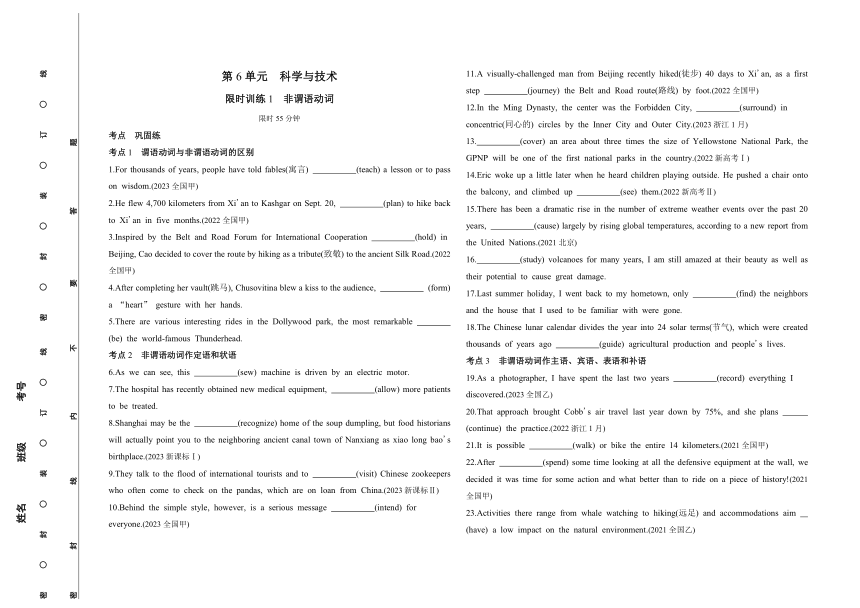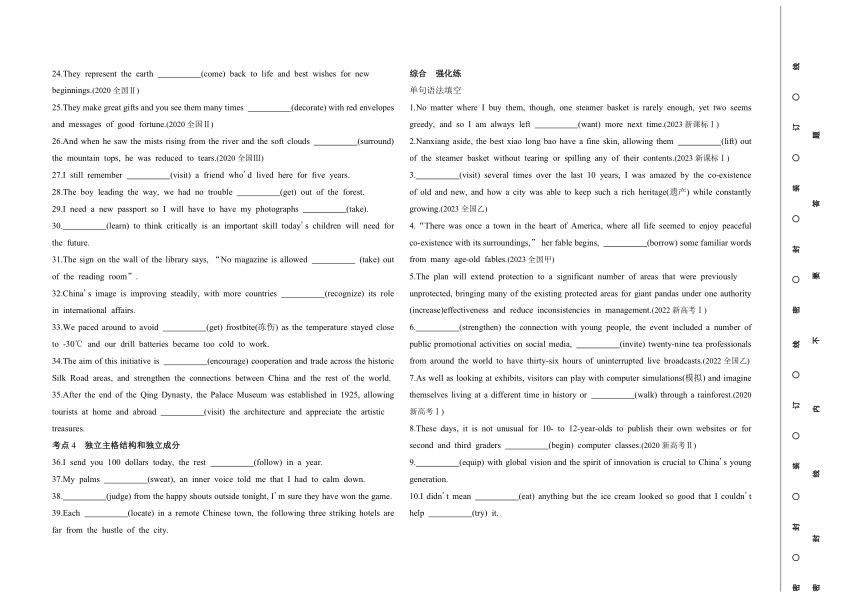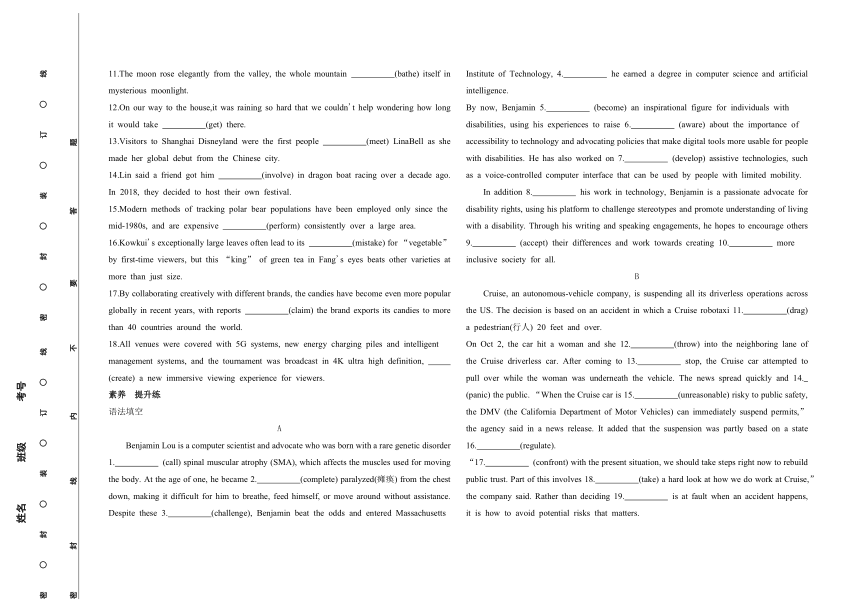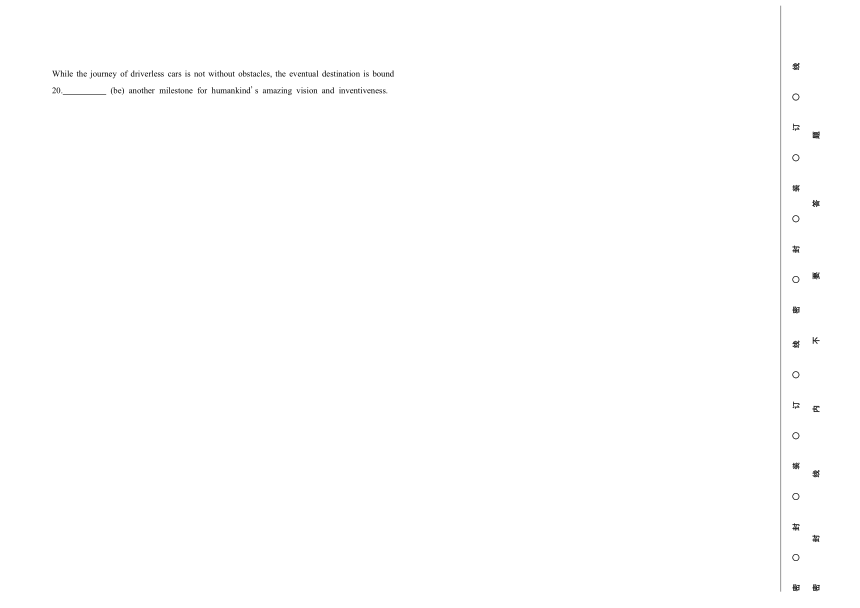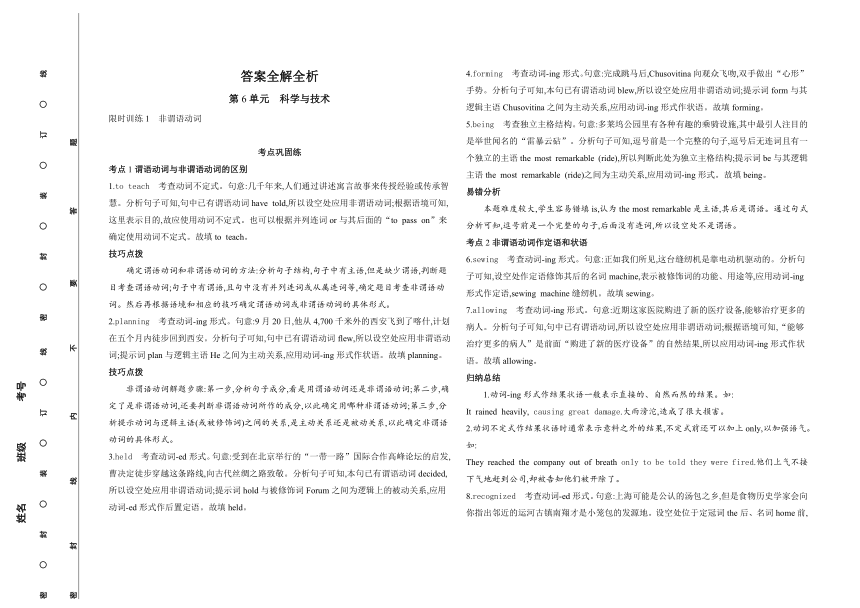 資源簡(jiǎn)介
資源簡(jiǎn)介
第6單元 科學(xué)與技術(shù)
限時(shí)訓(xùn)練1 非謂語(yǔ)動(dòng)詞
限時(shí)55分鐘
考點(diǎn) 鞏固練
考點(diǎn)1 謂語(yǔ)動(dòng)詞與非謂語(yǔ)動(dòng)詞的區(qū)別
1.For thousands of years, people have told fables(寓言) (teach) a lesson or to pass on wisdom.(2023全國(guó)甲)
2.He flew 4,700 kilometers from Xi'an to Kashgar on Sept. 20, (plan) to hike back to Xi'an in five months.(2022全國(guó)甲)
3.Inspired by the Belt and Road Forum for International Cooperation (hold) in Beijing, Cao decided to cover the route by hiking as a tribute(致敬) to the ancient Silk Road.(2022全國(guó)甲)
4.After completing her vault(跳馬), Chusovitina blew a kiss to the audience, (form) a “heart” gesture with her hands.
5.There are various interesting rides in the Dollywood park, the most remarkable (be) the world-famous Thunderhead.
考點(diǎn)2 非謂語(yǔ)動(dòng)詞作定語(yǔ)和狀語(yǔ)
6.As we can see, this (sew) machine is driven by an electric motor.
7.The hospital has recently obtained new medical equipment, (allow) more patients to be treated.
8.Shanghai may be the (recognize) home of the soup dumpling, but food historians will actually point you to the neighboring ancient canal town of Nanxiang as xiao long bao's birthplace.(2023新課標(biāo)Ⅰ)
9.They talk to the flood of international tourists and to (visit) Chinese zookeepers who often come to check on the pandas, which are on loan from China.(2023新課標(biāo)Ⅱ)
10.Behind the simple style, however, is a serious message (intend) for everyone.(2023全國(guó)甲)
11.A visually-challenged man from Beijing recently hiked(徒步) 40 days to Xi'an, as a first step (journey) the Belt and Road route(路線) by foot.(2022全國(guó)甲)
12.In the Ming Dynasty, the center was the Forbidden City, (surround) in concentric(同心的) circles by the Inner City and Outer City.(2023浙江1月)
13. (cover) an area about three times the size of Yellowstone National Park, the GPNP will be one of the first national parks in the country.(2022新高考Ⅰ)
14.Eric woke up a little later when he heard children playing outside. He pushed a chair onto the balcony, and climbed up (see) them.(2022新高考Ⅱ)
15.There has been a dramatic rise in the number of extreme weather events over the past 20 years, (cause) largely by rising global temperatures, according to a new report from the United Nations.(2021北京)
16. (study) volcanoes for many years, I am still amazed at their beauty as well as their potential to cause great damage.
17.Last summer holiday, I went back to my hometown, only (find) the neighbors and the house that I used to be familiar with were gone.
18.The Chinese lunar calendar divides the year into 24 solar terms(節(jié)氣), which were created thousands of years ago (guide) agricultural production and people's lives.
考點(diǎn)3 非謂語(yǔ)動(dòng)詞作主語(yǔ)、賓語(yǔ)、表語(yǔ)和補(bǔ)語(yǔ)
19.As a photographer, I have spent the last two years (record) everything I discovered.(2023全國(guó)乙)
20.That approach brought Cobb's air travel last year down by 75%, and she plans (continue) the practice.(2022浙江1月)
21.It is possible (walk) or bike the entire 14 kilometers.(2021全國(guó)甲)
22.After (spend) some time looking at all the defensive equipment at the wall, we decided it was time for some action and what better than to ride on a piece of history!(2021全國(guó)甲)
23.Activities there range from whale watching to hiking(遠(yuǎn)足) and accommodations aim (have) a low impact on the natural environment.(2021全國(guó)乙)
24.They represent the earth (come) back to life and best wishes for new beginnings.(2020全國(guó)Ⅱ)
25.They make great gifts and you see them many times (decorate) with red envelopes and messages of good fortune.(2020全國(guó)Ⅱ)
26.And when he saw the mists rising from the river and the soft clouds (surround) the mountain tops, he was reduced to tears.(2020全國(guó)Ⅲ)
27.I still remember (visit) a friend who'd lived here for five years.
28.The boy leading the way, we had no trouble (get) out of the forest.
29.I need a new passport so I will have to have my photographs (take).
30. (learn) to think critically is an important skill today's children will need for the future.
31.The sign on the wall of the library says, “No magazine is allowed (take) out of the reading room”.
32.China's image is improving steadily, with more countries (recognize) its role in international affairs.
33.We paced around to avoid (get) frostbite(凍傷) as the temperature stayed close to -30℃ and our drill batteries became too cold to work.
34.The aim of this initiative is (encourage) cooperation and trade across the historic Silk Road areas, and strengthen the connections between China and the rest of the world.
35.After the end of the Qing Dynasty, the Palace Museum was established in 1925, allowing tourists at home and abroad (visit) the architecture and appreciate the artistic treasures.
考點(diǎn)4 獨(dú)立主格結(jié)構(gòu)和獨(dú)立成分
36.I send you 100 dollars today, the rest (follow) in a year.
37.My palms (sweat), an inner voice told me that I had to calm down.
38. (judge) from the happy shouts outside tonight, I'm sure they have won the game.
39.Each (locate) in a remote Chinese town, the following three striking hotels are far from the hustle of the city.
綜合 強(qiáng)化練
單句語(yǔ)法填空
1.No matter where I buy them, though, one steamer basket is rarely enough, yet two seems greedy, and so I am always left (want) more next time.(2023新課標(biāo)Ⅰ)
2.Nanxiang aside, the best xiao long bao have a fine skin, allowing them (lift) out of the steamer basket without tearing or spilling any of their contents.(2023新課標(biāo)Ⅰ)
3. (visit) several times over the last 10 years, I was amazed by the co-existence of old and new, and how a city was able to keep such a rich heritage(遺產(chǎn)) while constantly growing.(2023全國(guó)乙)
4.“There was once a town in the heart of America, where all life seemed to enjoy peaceful co-existence with its surroundings,” her fable begins, (borrow) some familiar words from many age-old fables.(2023全國(guó)甲)
5.The plan will extend protection to a significant number of areas that were previously unprotected, bringing many of the existing protected areas for giant pandas under one authority (increase)effectiveness and reduce inconsistencies in management.(2022新高考Ⅰ)
6. (strengthen) the connection with young people, the event included a number of public promotional activities on social media, (invite) twenty-nine tea professionals from around the world to have thirty-six hours of uninterrupted live broadcasts.(2022全國(guó)乙)
7.As well as looking at exhibits, visitors can play with computer simulations(模擬) and imagine themselves living at a different time in history or (walk) through a rainforest.(2020新高考Ⅰ)
8.These days, it is not unusual for 10- to 12-year-olds to publish their own websites or for second and third graders (begin) computer classes.(2020新高考Ⅱ)
9. (equip) with global vision and the spirit of innovation is crucial to China's young generation.
10.I didn't mean (eat) anything but the ice cream looked so good that I couldn't help (try) it.
11.The moon rose elegantly from the valley, the whole mountain (bathe) itself in mysterious moonlight.
12.On our way to the house,it was raining so hard that we couldn't help wondering how long it would take (get) there.
13.Visitors to Shanghai Disneyland were the first people (meet) LinaBell as she made her global debut from the Chinese city.
14.Lin said a friend got him (involve) in dragon boat racing over a decade ago. In 2018, they decided to host their own festival.
15.Modern methods of tracking polar bear populations have been employed only since the mid-1980s, and are expensive (perform) consistently over a large area.
16.Kowkui's exceptionally large leaves often lead to its (mistake) for “vegetable” by first-time viewers, but this “king” of green tea in Fang's eyes beats other varieties at more than just size.
17.By collaborating creatively with different brands, the candies have become even more popular globally in recent years, with reports (claim) the brand exports its candies to more than 40 countries around the world.
18.All venues were covered with 5G systems, new energy charging piles and intelligent management systems, and the tournament was broadcast in 4K ultra high definition, (create) a new immersive viewing experience for viewers.
素養(yǎng) 提升練
語(yǔ)法填空
A
Benjamin Lou is a computer scientist and advocate who was born with a rare genetic disorder 1. (call) spinal muscular atrophy (SMA), which affects the muscles used for moving the body. At the age of one, he became 2. (complete) paralyzed(癱瘓) from the chest down, making it difficult for him to breathe, feed himself, or move around without assistance. Despite these 3. (challenge), Benjamin beat the odds and entered Massachusetts Institute of Technology, 4. he earned a degree in computer science and artificial intelligence.
By now, Benjamin 5. (become) an inspirational figure for individuals with disabilities, using his experiences to raise 6. (aware) about the importance of accessibility to technology and advocating policies that make digital tools more usable for people with disabilities. He has also worked on 7. (develop) assistive technologies, such as a voice-controlled computer interface that can be used by people with limited mobility.
In addition 8. his work in technology, Benjamin is a passionate advocate for disability rights, using his platform to challenge stereotypes and promote understanding of living with a disability. Through his writing and speaking engagements, he hopes to encourage others 9. (accept) their differences and work towards creating 10. more inclusive society for all.
B
Cruise, an autonomous-vehicle company, is suspending all its driverless operations across the US. The decision is based on an accident in which a Cruise robotaxi 11. (drag) a pedestrian(行人) 20 feet and over.
On Oct 2, the car hit a woman and she 12. (throw) into the neighboring lane of the Cruise driverless car. After coming to 13. stop, the Cruise car attempted to pull over while the woman was underneath the vehicle. The news spread quickly and 14. (panic) the public. “When the Cruise car is 15. (unreasonable) risky to public safety, the DMV (the California Department of Motor Vehicles) can immediately suspend permits,” the agency said in a news release. It added that the suspension was partly based on a state 16. (regulate).
“17. (confront) with the present situation, we should take steps right now to rebuild public trust. Part of this involves 18. (take) a hard look at how we do work at Cruise,” the company said. Rather than deciding 19. is at fault when an accident happens, it is how to avoid potential risks that matters.
While the journey of driverless cars is not without obstacles, the eventual destination is bound 20. (be) another milestone for humankind's amazing vision and inventiveness.
答案全解全析
第6單元 科學(xué)與技術(shù)
限時(shí)訓(xùn)練1 非謂語(yǔ)動(dòng)詞
考點(diǎn)鞏固練
考點(diǎn)1謂語(yǔ)動(dòng)詞與非謂語(yǔ)動(dòng)詞的區(qū)別
1.to teach 考查動(dòng)詞不定式。句意:幾千年來(lái),人們通過(guò)講述寓言故事來(lái)傳授經(jīng)驗(yàn)或傳承智慧。分析句子可知,句中已有謂語(yǔ)動(dòng)詞have told,所以設(shè)空處應(yīng)用非謂語(yǔ)動(dòng)詞;根據(jù)語(yǔ)境可知,這里表示目的,故應(yīng)使用動(dòng)詞不定式。也可以根據(jù)并列連詞or與其后面的“to pass on”來(lái)確定使用動(dòng)詞不定式。故填to teach。
技巧點(diǎn)撥
確定謂語(yǔ)動(dòng)詞和非謂語(yǔ)動(dòng)詞的方法:分析句子結(jié)構(gòu),句子中有主語(yǔ),但是缺少謂語(yǔ),判斷題目考查謂語(yǔ)動(dòng)詞;句子中有謂語(yǔ),且句中沒(méi)有并列連詞或從屬連詞等,確定題目考查非謂語(yǔ)動(dòng)詞。然后再根據(jù)語(yǔ)境和相應(yīng)的技巧確定謂語(yǔ)動(dòng)詞或非謂語(yǔ)動(dòng)詞的具體形式。
2.planning 考查動(dòng)詞-ing形式。句意:9月20日,他從4,700千米外的西安飛到了喀什,計(jì)劃在五個(gè)月內(nèi)徒步回到西安。分析句子可知,句中已有謂語(yǔ)動(dòng)詞flew,所以設(shè)空處應(yīng)用非謂語(yǔ)動(dòng)詞;提示詞plan與邏輯主語(yǔ)He之間為主動(dòng)關(guān)系,應(yīng)用動(dòng)詞-ing形式作狀語(yǔ)。故填planning。
技巧點(diǎn)撥
非謂語(yǔ)動(dòng)詞解題步驟:第一步,分析句子成分,看是用謂語(yǔ)動(dòng)詞還是非謂語(yǔ)動(dòng)詞;第二步,確定了是非謂語(yǔ)動(dòng)詞,還要判斷非謂語(yǔ)動(dòng)詞所作的成分,以此確定用哪種非謂語(yǔ)動(dòng)詞;第三步,分析提示動(dòng)詞與邏輯主語(yǔ)(或被修飾詞)之間的關(guān)系,是主動(dòng)關(guān)系還是被動(dòng)關(guān)系,以此確定非謂語(yǔ)動(dòng)詞的具體形式。
3.held 考查動(dòng)詞-ed形式。句意:受到在北京舉行的“一帶一路”國(guó)際合作高峰論壇的啟發(fā),曹決定徒步穿越這條路線,向古代絲綢之路致敬。分析句子可知,本句已有謂語(yǔ)動(dòng)詞decided,所以設(shè)空處應(yīng)用非謂語(yǔ)動(dòng)詞;提示詞hold與被修飾詞Forum之間為邏輯上的被動(dòng)關(guān)系,應(yīng)用動(dòng)詞-ed形式作后置定語(yǔ)。故填held。
4.forming 考查動(dòng)詞-ing形式。句意:完成跳馬后,Chusovitina向觀眾飛吻,雙手做出“心形”手勢(shì)。分析句子可知,本句已有謂語(yǔ)動(dòng)詞blew,所以設(shè)空處應(yīng)用非謂語(yǔ)動(dòng)詞;提示詞form與其邏輯主語(yǔ)Chusovitina之間為主動(dòng)關(guān)系,應(yīng)用動(dòng)詞-ing形式作狀語(yǔ)。故填forming。
5.being 考查獨(dú)立主格結(jié)構(gòu)。句意:多萊塢公園里有各種有趣的乘騎設(shè)施,其中最引人注目的是舉世聞名的“雷暴云砧”。分析句子可知,逗號(hào)前是一個(gè)完整的句子,逗號(hào)后無(wú)連詞且有一個(gè)獨(dú)立的主語(yǔ)the most remarkable (ride),所以判斷此處為獨(dú)立主格結(jié)構(gòu);提示詞be與其邏輯主語(yǔ)the most remarkable (ride)之間為主動(dòng)關(guān)系,應(yīng)用動(dòng)詞-ing形式。故填being。
易錯(cuò)分析
本題難度較大,學(xué)生容易錯(cuò)填is,認(rèn)為the most remarkable是主語(yǔ),其后是謂語(yǔ)。通過(guò)句式分析可知,逗號(hào)前是一個(gè)完整的句子,后面沒(méi)有連詞,所以設(shè)空處不是謂語(yǔ)。
考點(diǎn)2非謂語(yǔ)動(dòng)詞作定語(yǔ)和狀語(yǔ)
6.sewing 考查動(dòng)詞-ing形式。句意:正如我們所見(jiàn),這臺(tái)縫紉機(jī)是靠電動(dòng)機(jī)驅(qū)動(dòng)的。分析句子可知,設(shè)空處作定語(yǔ)修飾其后的名詞machine,表示被修飾詞的功能、用途等,應(yīng)用動(dòng)詞-ing形式作定語(yǔ),sewing machine縫紉機(jī)。故填sewing。
7.allowing 考查動(dòng)詞-ing形式。句意:近期這家醫(yī)院購(gòu)進(jìn)了新的醫(yī)療設(shè)備,能夠治療更多的病人。分析句子可知,句中已有謂語(yǔ)動(dòng)詞,所以設(shè)空處應(yīng)用非謂語(yǔ)動(dòng)詞;根據(jù)語(yǔ)境可知,“能夠治療更多的病人”是前面“購(gòu)進(jìn)了新的醫(yī)療設(shè)備”的自然結(jié)果,所以應(yīng)用動(dòng)詞-ing形式作狀語(yǔ)。故填allowing。
歸納總結(jié)
1.動(dòng)詞-ing形式作結(jié)果狀語(yǔ)一般表示直接的、自然而然的結(jié)果。如:
It rained heavily, causing great damage.大雨滂沱,造成了很大損害。
2.動(dòng)詞不定式作結(jié)果狀語(yǔ)時(shí)通常表示意料之外的結(jié)果,不定式前還可以加上only,以加強(qiáng)語(yǔ)氣。如:
They reached the company out of breath only to be told they were fired.他們上氣不接下氣地趕到公司,卻被告知他們被開(kāi)除了。
8.recognized 考查動(dòng)詞-ed形式。句意:上海可能是公認(rèn)的湯包之鄉(xiāng),但是食物歷史學(xué)家會(huì)向你指出鄰近的運(yùn)河古鎮(zhèn)南翔才是小籠包的發(fā)源地。設(shè)空處位于定冠詞the后、名詞home前,因此應(yīng)該使用非謂語(yǔ)動(dòng)詞作定語(yǔ);提示詞recognize與被修飾詞home之間是被動(dòng)關(guān)系,應(yīng)用動(dòng)詞-ed形式。故填recognized。
歸納總結(jié)
1.單個(gè)動(dòng)詞-ed形式作定語(yǔ)時(shí),通常放在被修飾的名詞前面;動(dòng)詞-ed形式短語(yǔ)作定語(yǔ)時(shí),通常放在被修飾的名詞后面。
2.動(dòng)詞-ed形式作定語(yǔ)時(shí),與被修飾的名詞之間通常是被動(dòng)關(guān)系,表示被動(dòng)和完成。
3.也有一些動(dòng)詞-ed形式作定語(yǔ)只表示完成,不表示被動(dòng),如:a fallen tree/leaf倒下的樹(shù)/落葉;the risen sun/moon升起的太陽(yáng)/月亮;a faded rose凋謝的玫瑰花;a retired worker退休工人;an escaped prisoner逃犯;a returned student歸國(guó)留學(xué)生。
9.visiting 考查動(dòng)詞-ing形式。句意:他們要與蜂擁而至的國(guó)際游客和經(jīng)常前來(lái)查看這些熊貓的中國(guó)飼養(yǎng)員交談,這些熊貓是從中國(guó)租借來(lái)的。分析句子可知,設(shè)空處作定語(yǔ)修飾其后的名詞短語(yǔ)Chinese zookeepers,兩者之間是邏輯上的主動(dòng)關(guān)系,應(yīng)用動(dòng)詞-ing形式。故填visiting。
歸納總結(jié)
1.單個(gè)動(dòng)詞-ing形式作定語(yǔ)時(shí),通常放在被修飾的名詞前面;動(dòng)詞-ing形式短語(yǔ)作定語(yǔ)時(shí),通常放在被修飾的名詞后面。
2.動(dòng)詞-ing形式作定語(yǔ)時(shí),與被修飾的名詞之間通常是主動(dòng)關(guān)系,表示主動(dòng)和進(jìn)行。
10.intended 考查動(dòng)詞-ed形式。句意:然而,在簡(jiǎn)潔的風(fēng)格背后,是向每個(gè)人傳達(dá)的嚴(yán)肅信息。分析句子可知,設(shè)空處作定語(yǔ)修飾名詞message,根據(jù)短語(yǔ)be intended for“為……打算(或設(shè)計(jì))的”可知,設(shè)空處應(yīng)用動(dòng)詞-ed形式。故填intended。
11.to journey 考查動(dòng)詞不定式。句意:近日,一名來(lái)自北京的失明男子徒步40天來(lái)到西安,作為“一帶一路”路線徒步旅行的第一步。分析句子并結(jié)合語(yǔ)境可知,提示詞journey在這里為動(dòng)詞,表示“旅行”;設(shè)空處修飾前面的名詞step,而step被序數(shù)詞first修飾,所以應(yīng)用動(dòng)詞不定式作后置定語(yǔ)。故填to journey。
歸納總結(jié)
1.動(dòng)詞不定式作定語(yǔ)時(shí)通常放在被修飾詞之后,表示將來(lái)的動(dòng)作。動(dòng)詞不定式與被修飾詞之間往往是動(dòng)賓關(guān)系;若該不定式是不及物的,其后應(yīng)加上相應(yīng)的介詞。如:
Suddenly a good idea occurred to her,but she couldn't find any paper to write on.突然她想到了一個(gè)好主意,但是她找不到(把它)寫下來(lái)的紙。
2.在序數(shù)詞、形容詞的最高級(jí)、the last、the only等后面或被這些詞修飾的名詞或代詞后面,常用動(dòng)詞不定式作定語(yǔ)。如:
The first woman to cross the English Channel was Gertrude Ederle in 1926.1926年,格特魯?shù)隆ぐ5聽(tīng)柍蔀榈谝晃粰M渡英吉利海峽的女性。
3.當(dāng)被修飾詞是某些抽象名詞時(shí),常用動(dòng)詞不定式作定語(yǔ)。常見(jiàn)的這類抽象名詞有:ability、chance、idea、wish、excuse、promise、attempt、way 等。如:
He has blind faith in doctors' ability to find a cure.他盲目相信醫(yī)生有妙手回春的能力。
12.surrounded 考查動(dòng)詞-ed形式。句意:在明朝,紫禁城是中心,它被由內(nèi)城和外城構(gòu)成的同心圓包圍。分析句子可知,句中已有系動(dòng)詞was,所以設(shè)空處應(yīng)用非謂語(yǔ)動(dòng)詞;提示詞surround和被修飾詞the Forbidden City之間是被動(dòng)關(guān)系,應(yīng)用動(dòng)詞-ed形式作后置定語(yǔ)。故填surrounded。
13.Covering 考查動(dòng)詞-ing形式。句意:大熊貓國(guó)家公園占地面積約為黃石國(guó)家公園的三倍,將成為中國(guó)首批國(guó)家公園之一。分析句子可知,句中已有系動(dòng)詞be,所以設(shè)空處應(yīng)用非謂語(yǔ)動(dòng)詞;提示詞cover和句子主語(yǔ)the GPNP之間是主動(dòng)關(guān)系,應(yīng)用動(dòng)詞-ing形式作狀語(yǔ)。故填Covering。
14.to see 考查動(dòng)詞不定式。句意:過(guò)了一會(huì)兒,埃里克聽(tīng)到孩子們?cè)谕饷嫱嫠5穆曇?醒了過(guò)來(lái)。他把一把椅子推到陽(yáng)臺(tái)上,爬上去看他們。分析句子可知,句中已有謂語(yǔ)動(dòng)詞pushed和climbed,所以設(shè)空處應(yīng)用非謂語(yǔ)動(dòng)詞;根據(jù)語(yǔ)境可知,此處表示目的,應(yīng)該使用動(dòng)詞不定式作目的狀語(yǔ)。故填to see。
15.caused 考查動(dòng)詞-ed形式。句意:根據(jù)聯(lián)合國(guó)的一份新報(bào)告,過(guò)去二十年里,極端天氣事件的數(shù)量急劇增加,這在很大程度上是由全球氣溫上升造成的。分析句子可知,句中已有謂語(yǔ)動(dòng)詞,所以設(shè)空處應(yīng)用非謂語(yǔ)動(dòng)詞;提示詞cause與被修飾詞a dramatic rise in the number of extreme weather events之間是邏輯上的被動(dòng)關(guān)系,應(yīng)用動(dòng)詞-ed形式作后置定語(yǔ)。故填caused。
16.Having studied 考查動(dòng)詞-ing形式。句意:在研究火山多年之后,我仍然對(duì)它們的美麗以及它們?cè)斐删薮笃茐牡臐摿Ω械襟@訝。分析句子可知,句中已有謂語(yǔ)動(dòng)詞,所以設(shè)空處應(yīng)用非謂語(yǔ)動(dòng)詞;提示詞study與句子主語(yǔ)I之間是邏輯上的主動(dòng)關(guān)系,且根據(jù)“for many years”可知這里強(qiáng)調(diào)“研究”的動(dòng)作發(fā)生在句子謂語(yǔ)動(dòng)作之前,應(yīng)該使用動(dòng)詞-ing形式的完成式作狀語(yǔ)。故填Having studied。
歸納總結(jié)
1.作狀語(yǔ)的動(dòng)詞-ing形式的邏輯主語(yǔ)要與句子的主語(yǔ)保持一致。
2.若動(dòng)詞-ing形式表示的動(dòng)作發(fā)生在句子謂語(yǔ)動(dòng)詞所表示的動(dòng)作之前,則用動(dòng)詞-ing形式的完成式(having done)。
3.若動(dòng)詞-ing形式表示的動(dòng)作發(fā)生在句子謂語(yǔ)動(dòng)詞所表示的動(dòng)作之前,且動(dòng)詞-ing形式與句子主語(yǔ)之間為邏輯上的被動(dòng)關(guān)系,則用動(dòng)詞-ing形式的完成式的被動(dòng)形式(having been done)。
17.to find 考查動(dòng)詞不定式。句意:去年暑假,我回到家鄉(xiāng),卻發(fā)現(xiàn)我曾熟悉的鄰居和房子已經(jīng)不見(jiàn)了。分析句子可知,句中已有謂語(yǔ)動(dòng)詞,所以設(shè)空處應(yīng)用非謂語(yǔ)動(dòng)詞;根據(jù)語(yǔ)境和only可知,此處表示出乎意料的結(jié)果,應(yīng)用動(dòng)詞不定式作結(jié)果狀語(yǔ)。故填to find。
18.to guide 考查動(dòng)詞不定式。句意:中國(guó)農(nóng)歷將一年分為24個(gè)節(jié)氣,這些節(jié)氣是幾千年前創(chuàng)造的,用來(lái)指導(dǎo)農(nóng)業(yè)生產(chǎn)和人們的生活。分析句子可知,定語(yǔ)從句中已有謂語(yǔ)動(dòng)詞,所以設(shè)空處應(yīng)用非謂語(yǔ)動(dòng)詞;根據(jù)語(yǔ)境可知,此處表示目的,應(yīng)用動(dòng)詞不定式作目的狀語(yǔ)。故填to guide。
考點(diǎn)3非謂語(yǔ)動(dòng)詞作主語(yǔ)、賓語(yǔ)、表語(yǔ)和補(bǔ)語(yǔ)
19.recording 考查動(dòng)詞-ing形式。句意:作為一名攝影師,我已經(jīng)花費(fèi)過(guò)去的兩年時(shí)間來(lái)記錄我發(fā)現(xiàn)的一切。本句已有謂語(yǔ)動(dòng)詞have spent,所以設(shè)空處應(yīng)用非謂語(yǔ)動(dòng)詞;spend time (in) doing sth.意為“花費(fèi)時(shí)間做某事”。故填recording。
聯(lián)想拓展
常見(jiàn)的接動(dòng)詞-ing形式作賓語(yǔ)的結(jié)構(gòu):be busy/occupied (in) doing忙于做;when it comes to doing當(dāng)談到做;spend time (in) doing花費(fèi)時(shí)間做;have difficulty/trouble (in) doing做某事有困難;there is no point (in) doing做某事沒(méi)有意義;have a good time(in) doing做某事很愉快。
20.to continue 考查動(dòng)詞不定式。句意:那種方法使Cobb去年的航空旅行減少了75%,她計(jì)劃繼續(xù)這種做法。動(dòng)詞plan后面跟動(dòng)詞不定式作賓語(yǔ),plan to do sth.表示“計(jì)劃做某事”。故填to continue。
聯(lián)想拓展
常見(jiàn)的接動(dòng)詞不定式作賓語(yǔ)的動(dòng)詞有agree、plan、demand、promise、prepare、decide、refuse、choose、wish、hope、expect、fail (未能)、pretend、manage、determine、beg、arrange、threaten、claim、hesitate、wait、happen (碰巧)等。
21.to walk 考查動(dòng)詞不定式。句意:可以步行或騎自行車完成這全部14千米。分析句子可知,本句為“It is+adj.+to do sth.”句型,其中It為形式主語(yǔ),動(dòng)詞不定式是真正的主語(yǔ)。故填 to walk。
技巧點(diǎn)撥
表示具體的某次動(dòng)作,特別是將來(lái)發(fā)生的動(dòng)作,多用動(dòng)詞不定式作主語(yǔ);表示比較抽象的一般行為或者經(jīng)常性、習(xí)慣性的動(dòng)作時(shí),多用動(dòng)詞-ing形式作主語(yǔ)。
22.spending 考查動(dòng)詞-ing形式。句意:在花了一些時(shí)間看了墻上的所有防御設(shè)施后,我們決定是時(shí)候采取一些行動(dòng)了,還有什么比在歷史遺跡上騎行更好的呢!分析句子可知,設(shè)空處作介詞After的賓語(yǔ)且提示詞spend與句子主語(yǔ)we之間為邏輯上的主動(dòng)關(guān)系,應(yīng)用動(dòng)詞-ing形式。故填spending。
23.to have 考查動(dòng)詞不定式。句意:那里的活動(dòng)包括從觀賞鯨到遠(yuǎn)足,并且食宿力求減少對(duì)自然環(huán)境的影響。分析句子可知,and連接兩個(gè)并列分句,后一分句的謂語(yǔ)動(dòng)詞是aim,其后跟動(dòng)詞不定式作賓語(yǔ),aim to do sth.意為“力求做某事”。故填to have。
ing 考查動(dòng)詞-ing形式。句意:它們代表著大地的復(fù)蘇和對(duì)新開(kāi)端的最好的祝愿。分析句子可知,設(shè)空處在句中作謂語(yǔ)動(dòng)詞represent的賓語(yǔ),應(yīng)用所給詞的動(dòng)詞-ing形式,the earth是其邏輯主語(yǔ)。故填coming。
25.decorated 考查動(dòng)詞-ed形式。句意:它們是很好的禮物,你會(huì)經(jīng)常看到它們被紅包和好運(yùn)的信息裝飾著。根據(jù)空前的“see them many times”可知,設(shè)空處作賓語(yǔ)補(bǔ)足語(yǔ),賓語(yǔ)them與提示詞decorate之間是被動(dòng)關(guān)系,所以應(yīng)用動(dòng)詞-ed形式。故填decorated。
26.surrounding 考查動(dòng)詞-ing形式。句意:當(dāng)他看到霧氣從江上升起,柔軟的云環(huán)繞山頂,他不禁流下了眼淚。根據(jù)空前的“saw the mists rising from the river and the soft clouds”可知,設(shè)空處作賓語(yǔ)補(bǔ)足語(yǔ),提示詞surround與賓語(yǔ)the soft clouds之間是主動(dòng)關(guān)系,應(yīng)用動(dòng)詞-ing形式。故填surrounding。
27.visiting 考查動(dòng)詞-ing形式。句意:我還記得拜訪了一位在這里住了五年的朋友。根據(jù)語(yǔ)境可知,此處指“我仍記得拜訪過(guò)一個(gè)朋友”,remember doing sth.表示“記得做過(guò)某事”。故填visiting。
聯(lián)想拓展
常見(jiàn)的接動(dòng)詞不定式與動(dòng)詞-ing形式作賓語(yǔ)時(shí)意思不同的動(dòng)詞(短語(yǔ)):
28.getting 考查動(dòng)詞-ing形式。句意:由那個(gè)男孩帶路,我們毫不費(fèi)勁地走出了森林。固定結(jié)構(gòu)have trouble/difficulty (in) doing表示“做某事有困難”,所以應(yīng)用動(dòng)詞-ing形式。故填getting。
29.taken 考查動(dòng)詞-ed形式。句意:我需要一本新護(hù)照,所以我將不得不拍照片。根據(jù)空前的“have my photographs”可知設(shè)空處作賓語(yǔ)補(bǔ)足語(yǔ);賓語(yǔ)my photographs與提示詞take之間是被動(dòng)關(guān)系,應(yīng)用動(dòng)詞-ed形式。故填taken。
聯(lián)想拓展
常見(jiàn)的可接動(dòng)詞-ing形式和動(dòng)詞-ed形式作賓補(bǔ)的動(dòng)詞主要是感官動(dòng)詞和使役動(dòng)詞:see、watch、observe、notice、hear、listen to、feel、have、make、get、leave、keep等。
30.Learning 考查動(dòng)詞-ing形式。句意:學(xué)會(huì)批判性思考是當(dāng)代孩子們未來(lái)所需的重要技能。分析句子可知,設(shè)空處作主語(yǔ),表示抽象的、泛指的概念,應(yīng)用動(dòng)詞-ing形式。故填Learning。
歸納總結(jié)
1.動(dòng)詞-ing形式作主語(yǔ)常表示抽象的、泛指的概念;
2.可用it作形式主語(yǔ),把真正的主語(yǔ),即動(dòng)詞-ing形式(短語(yǔ))放在句末,常用固定句型:“It is a waste of time doing...”“It is no use/good doing...”“It is useless doing...”等。
31.to be taken 考查動(dòng)詞不定式。句意:圖書館墻上的牌子上寫著:“雜志不允許帶出閱覽室。”allow sb. to do sth.意為“允許某人做某事”,其被動(dòng)形式為“sb. be allowed to do sth.”;提示詞take和主語(yǔ)magazine之間為被動(dòng)關(guān)系,所以應(yīng)用動(dòng)詞不定式的被動(dòng)形式作主語(yǔ)補(bǔ)足語(yǔ)。故填to be taken。
歸納總結(jié)
動(dòng)詞不定式有一般式、進(jìn)行式和完成式三種時(shí)態(tài)變化形式,見(jiàn)下表:
形 式 意義 主動(dòng) 語(yǔ)態(tài) 被動(dòng) 語(yǔ)態(tài)
一 般 式 表示的動(dòng)作通常時(shí)間性不強(qiáng),與謂語(yǔ)動(dòng)詞表示的動(dòng)作沒(méi)有明顯的先后順序 to write to be written
進(jìn) 行 式 表示的動(dòng)作與謂語(yǔ)動(dòng)詞表示的動(dòng)作同時(shí)發(fā)生 to be writing
完 成 式 表示的動(dòng)作發(fā)生在謂語(yǔ)動(dòng)詞表示的動(dòng)作之前 to have written to have been written
32.recognizing 考查動(dòng)詞-ing形式。句意:中國(guó)的形象正在穩(wěn)步提升,有更多的國(guó)家認(rèn)識(shí)到中國(guó)在國(guó)際事務(wù)中的作用。此處為with的復(fù)合結(jié)構(gòu),設(shè)空處作賓語(yǔ)補(bǔ)足語(yǔ),賓語(yǔ)more countries與提示詞recognize之間是主動(dòng)關(guān)系,應(yīng)用動(dòng)詞-ing形式。故填recognizing。
歸納總結(jié)
with的復(fù)合結(jié)構(gòu):
with+賓語(yǔ)+doing表示主動(dòng)或進(jìn)行;
with+賓語(yǔ)+done表示被動(dòng)或完成;
with+賓語(yǔ)+to do表示將來(lái)的動(dòng)作。
33.getting 考查動(dòng)詞-ing形式。句意:由于溫度保持在-30℃附近并且我們的鉆機(jī)電池變得太冷而無(wú)法工作,因此我們四處走動(dòng)以避免凍傷。avoid后面跟動(dòng)詞-ing形式作賓語(yǔ),avoid doing sth.意為“避免做某事”。故填getting。
聯(lián)想拓展
常接動(dòng)詞-ing形式作賓語(yǔ)的動(dòng)詞(短語(yǔ))記憶口訣:考慮建議盼原諒(consider、suggest/advise、look forward to、excuse/pardon);承認(rèn)推遲很想要(admit、delay/put off、fancy);避免錯(cuò)過(guò)繼續(xù)練(avoid、miss、keep/keep on、practice);否認(rèn)完成就欣賞(deny、finish、enjoy/appreciate);禁止想象才冒險(xiǎn)(forbid、imagine、risk);不禁介意準(zhǔn)逃亡(can't help、mind、allow/permit、escape)。
34.to encourage 考查動(dòng)詞不定式。句意:這項(xiàng)倡議的目的是鼓勵(lì)橫跨歷史悠久的絲綢之路地區(qū)的合作與貿(mào)易,同時(shí)加強(qiáng)中國(guó)與世界其他地區(qū)之間的聯(lián)系。分析句子可知,設(shè)空處作表語(yǔ),說(shuō)明主語(yǔ)的具體內(nèi)容,應(yīng)用動(dòng)詞不定式。故填to encourage。
歸納總結(jié)
主語(yǔ)是以aim、ambition、duty、hope、idea、intention、plan、purpose、suggestion等名詞為中心詞的名詞詞組時(shí),常用動(dòng)詞不定式作表語(yǔ),表示主語(yǔ)的具體內(nèi)容、目的等。
35.to visit 考查動(dòng)詞不定式。句意:清朝結(jié)束后,故宮博物院于1925年建立,使國(guó)內(nèi)外游客能夠參觀建筑和欣賞藝術(shù)珍品。allow后面跟動(dòng)詞不定式作賓語(yǔ)補(bǔ)足語(yǔ),allow sb. to do sth.意為“使某人能夠做某事”。故填to visit。
聯(lián)想拓展
常接動(dòng)詞不定式作賓語(yǔ)補(bǔ)足語(yǔ)的動(dòng)詞有:ask、beg、require、request、advise、allow、permit、cause、encourage、expect、force、invite、order、persuade、remind、teach、urge、hate、warn、help、prefer等。
技巧點(diǎn)撥
動(dòng)詞不定式在feel、hear、listen to、look at、see、watch、notice、let、make、have等動(dòng)詞后面作賓語(yǔ)補(bǔ)足語(yǔ)時(shí)要省略不定式符號(hào)to;但這些動(dòng)詞使用被動(dòng)語(yǔ)態(tài)時(shí),省略的to要還原。如:
The teacher is often listened to to sing English songs at home.這位老師經(jīng)常被聽(tīng)到在家里唱英文歌。
考點(diǎn)4獨(dú)立主格結(jié)構(gòu)和獨(dú)立成分
36.to follow 考查獨(dú)立主格結(jié)構(gòu)。句意:我今天給你100美元,其余的一年后再給你。分析句子可知,逗號(hào)后面為獨(dú)立主格結(jié)構(gòu),提示詞follow與其邏輯主語(yǔ)the rest之間是主動(dòng)關(guān)系,且由in a year可知,設(shè)空處表示的動(dòng)作還未發(fā)生,應(yīng)用動(dòng)詞不定式。故填to follow。
歸納總結(jié)
1.獨(dú)立主格結(jié)構(gòu)的定義:非謂語(yǔ)動(dòng)詞作狀語(yǔ)時(shí),通常它的邏輯主語(yǔ)和句子的主語(yǔ)一致,但有時(shí)非謂語(yǔ)動(dòng)詞帶有自己的邏輯主語(yǔ),這種結(jié)構(gòu)我們就稱之為獨(dú)立主格結(jié)構(gòu)。
2.獨(dú)立主格結(jié)構(gòu)的特點(diǎn):(1)獨(dú)立主格結(jié)構(gòu)的邏輯主語(yǔ)與句子的主語(yǔ)不同,它獨(dú)立存在;(2)獨(dú)立主格結(jié)構(gòu)中作邏輯主語(yǔ)的名詞或代詞與后面的分詞或不定式之間是邏輯上的主動(dòng)或被動(dòng)關(guān)系;(3)獨(dú)立主格結(jié)構(gòu)一般用逗號(hào)與句子分開(kāi)。
3.獨(dú)立主格結(jié)構(gòu)的常見(jiàn)構(gòu)成形式:(1)名詞/代詞+doing/done/to do;(2)with/without+名詞/代詞+doing/done/to do。
37.sweating 考查獨(dú)立主格結(jié)構(gòu)。句意:我手心冒汗,內(nèi)心有個(gè)聲音告訴我,我必須冷靜下來(lái)。分析句子可知,逗號(hào)前面為獨(dú)立主格結(jié)構(gòu),提示詞sweat與其邏輯主語(yǔ)My palms之間是主動(dòng)關(guān)系,應(yīng)用動(dòng)詞-ing形式。故填sweating。
38.Judging 考查獨(dú)立成分。句意:從今晚外面的歡呼聲來(lái)看,我肯定他們贏了比賽。judging from/by意為“根據(jù)……判斷,由……推測(cè)”,用作獨(dú)立成分,不用考慮邏輯關(guān)系的一致性。故填Judging。
歸納總結(jié)
有些分詞或不定式短語(yǔ)作狀語(yǔ)時(shí),其形式的選擇不受上下文的影響,稱作獨(dú)立成分。
聯(lián)想拓展
常見(jiàn)的獨(dú)立成分有:generally/frankly/roughly/strictly speaking;talking of...;speaking of...;judging from/by;taking everything into consideration;to be frank;to tell (you) the truth;to be honest;to make things worse等。
39.located 考查獨(dú)立主格結(jié)構(gòu)。句意:以下三家引人注目的酒店都位于中國(guó)偏遠(yuǎn)的城鎮(zhèn),遠(yuǎn)離城市的喧囂。分析句子可知,逗號(hào)前面是獨(dú)立主格結(jié)構(gòu),提示詞locate與其邏輯主語(yǔ)Each之間是被動(dòng)關(guān)系,應(yīng)用動(dòng)詞-ed形式。故填located。
綜合強(qiáng)化練
1.wanting 考查動(dòng)詞-ing形式。句意:可是無(wú)論我在哪里買,一蒸籠往往不夠,而兩蒸籠又顯得太貪心了,所以我總是想下次買更多。leave sb. doing sth.意為“讓某人一直做某事”,此處為其被動(dòng)形式“sb. be left doing sth.”。故填wanting。
2.to be lifted 考查動(dòng)詞不定式。句意:撇開(kāi)南翔不說(shuō),最好的小籠包有精致的表皮,可以讓它們從蒸籠中被拿出來(lái)時(shí)不會(huì)破皮,也不會(huì)灑出里面的任何東西。根據(jù)allow sb. to do sth.“允許某人做某事”可知,設(shè)空處應(yīng)用動(dòng)詞不定式作賓語(yǔ)補(bǔ)足語(yǔ);賓語(yǔ)them指代前面的“xiao long bao”,提示詞lift與賓語(yǔ)之間是邏輯上的被動(dòng)關(guān)系,所以設(shè)空處應(yīng)用動(dòng)詞不定式的被動(dòng)形式。故填to be lifted。
3.Having visited 考查動(dòng)詞-ing形式。句意:在過(guò)去的十年里,我已經(jīng)參觀了幾次,我驚訝于新舊共存,以及一個(gè)城市如何能在不斷發(fā)展的同時(shí)保存如此豐富的遺產(chǎn)。分析句子可知,設(shè)空處作狀語(yǔ);提示詞visit與其邏輯主語(yǔ)I之間為主動(dòng)關(guān)系,且根據(jù)時(shí)間狀語(yǔ)over the last 10 years可知,這里強(qiáng)調(diào)設(shè)空處表示的動(dòng)作先于謂語(yǔ)動(dòng)詞的動(dòng)作發(fā)生,應(yīng)用動(dòng)詞-ing形式的完成式。故填Having visited。
易錯(cuò)分析
本題容易錯(cuò)填Visiting,原因是不了解動(dòng)詞-ing形式的完成式的意義。動(dòng)詞-ing形式的完成式(having done)主要用作狀語(yǔ),表示這個(gè)動(dòng)作在謂語(yǔ)所表示的動(dòng)作之前發(fā)生。
4.borrowing 考查動(dòng)詞-ing形式。句意:“從前,在美國(guó)的中心地帶有一個(gè)小鎮(zhèn),那里所有的生命似乎都和周圍的環(huán)境一起享受著和平的生活,”她的寓言是這樣開(kāi)頭的,從許多古老寓言中借用了一些熟悉的詞。分析句子可知,設(shè)空處作狀語(yǔ);提示詞borrow與其邏輯主語(yǔ)her fable之間為主動(dòng)關(guān)系,應(yīng)用動(dòng)詞-ing形式。故填borrowing。
5.to increase 考查動(dòng)詞不定式。句意:該計(jì)劃將把保護(hù)范圍擴(kuò)大到大量以前未受保護(hù)的地區(qū),將許多現(xiàn)有的大熊貓保護(hù)區(qū)納入一個(gè)管理機(jī)構(gòu),以提高效率,減少管理上的不一致。分析句子可知,設(shè)空處表示目的,應(yīng)用動(dòng)詞不定式作目的狀語(yǔ)。故填to increase。
難句分析
protection to a significant number of areas
of the existing protected areas for giant pandas under one authority
reduce inconsistencies in management.
6.To strengthen; inviting 考查非謂語(yǔ)動(dòng)詞。句意:為了加強(qiáng)與年輕人的聯(lián)系,活動(dòng)包括在社交媒體上的許多公共宣傳活動(dòng),邀請(qǐng)了來(lái)自世界各地的29名茶葉專業(yè)人士進(jìn)行36小時(shí)不間斷的直播。分析句子可知,第一空表示目的,應(yīng)用動(dòng)詞不定式作目的狀語(yǔ),故填To strengthen;第二空作狀語(yǔ),提示詞invite與其邏輯主語(yǔ)the event之間為主動(dòng)關(guān)系,應(yīng)用動(dòng)詞-ing形式,故填inviting。
7.walking 考查動(dòng)詞-ing形式。句意:除了觀賞展品,游客還可以玩電腦模擬游戲,想象自己生活在一個(gè)不同的歷史時(shí)期,或者漫步在熱帶雨林中。分析句子可知,設(shè)空處與living并列,共同作imagine的賓語(yǔ)補(bǔ)足語(yǔ),imagine sb. doing sth.意為“想象某人做某事”。故填walking。
8.to begin 考查動(dòng)詞不定式。句意:如今,10到12歲的孩子發(fā)布自己的網(wǎng)站,或者二年級(jí)和三年級(jí)學(xué)生開(kāi)始上計(jì)算機(jī)課,這些都很常見(jiàn)。分析句子可知,本句為“It is+adj.+for sb. to do sth.”句型,其中It作形式主語(yǔ),真正的主語(yǔ)為動(dòng)詞不定式短語(yǔ)。故填to begin。
9.Being equipped 考查動(dòng)詞-ing形式。句意:具備全球視野和創(chuàng)新精神對(duì)于中國(guó)的年輕一代來(lái)說(shuō)很重要。分析句子可知,設(shè)空處作主語(yǔ),表示抽象的、泛指的概念,應(yīng)用動(dòng)詞-ing形式;be equipped with意為“具備,具有”,是固定短語(yǔ),作主語(yǔ)時(shí)be不能省略,需用being。故填Being equipped。
10.to eat; trying 考查非謂語(yǔ)動(dòng)詞。句意:我不打算吃任何東西,但這種冰激凌看起來(lái)如此好以至于我忍不住要試一試。根據(jù)語(yǔ)境可知,第一空表示“打算做”,應(yīng)用動(dòng)詞不定式作賓語(yǔ),故填to eat;第二空表示“禁不住做”,應(yīng)用動(dòng)詞-ing形式,故填trying。
11.bathing 考查獨(dú)立主格結(jié)構(gòu)。句意:月亮從山谷里優(yōu)雅地升起,整個(gè)高山沐浴在神秘的月光中。分析句子可知,逗號(hào)后面是獨(dú)立主格結(jié)構(gòu),提示詞bathe與其邏輯主語(yǔ)mountain之間是主動(dòng)關(guān)系,應(yīng)用動(dòng)詞-ing形式。故填bathing。
12.to get 考查動(dòng)詞不定式。句意:在我們?nèi)ツ亲孔拥穆飞?雨下得如此大以至于我們不禁想知道還要多久才能到那里。It takes time to do sth.意為“花時(shí)間做某事”,是固定句型,其中It為形式主語(yǔ),動(dòng)詞不定式短語(yǔ)作真正的主語(yǔ)。故填to get。
13.to meet 考查動(dòng)詞不定式。句意:上海迪士尼樂(lè)園的游客是第一批見(jiàn)到玲娜貝兒的人,因?yàn)樗窃谶@個(gè)中國(guó)城市進(jìn)行的全球首次亮相。“the+序數(shù)詞(+名詞)+to do”是固定搭配,意為“第幾個(gè)做……的……”,動(dòng)詞不定式作后置定語(yǔ)。故填to meet。
14.involved 考查動(dòng)詞-ed形式。句意:林說(shuō),十多年前一個(gè)朋友讓他參加了龍舟比賽。2018年,他們決定舉辦自己的節(jié)日。分析句子可知,設(shè)空處作賓語(yǔ)補(bǔ)足語(yǔ),賓語(yǔ)him與提示詞involve之間為邏輯上的被動(dòng)關(guān)系,應(yīng)用動(dòng)詞-ed形式。故填involved。
15.to perform 考查動(dòng)詞不定式。句意:現(xiàn)代化的跟蹤調(diào)查北極熊數(shù)量的方法自20世紀(jì)80年代中期以來(lái)才開(kāi)始被采用。這些方法在一大片區(qū)域里持續(xù)使用起來(lái)費(fèi)用很高。分析句子可知,此處為“sth.+be+adj.+to do”結(jié)構(gòu),其中動(dòng)詞不定式作狀語(yǔ),用主動(dòng)形式表示被動(dòng)意義。故填to perform。
歸納總結(jié)
在一些主系表結(jié)構(gòu)“sth.+be+adj.”后面,常用動(dòng)詞不定式作方式狀語(yǔ)。
16.being mistaken 考查動(dòng)詞-ing形式。句意:猴魁茶的葉子特別大,經(jīng)常導(dǎo)致第一次看到的人誤認(rèn)為其是“蔬菜”,但在方看來(lái),這種綠茶“王”勝過(guò)其他品種的不僅僅是大小。分析句子可知,設(shè)空處作lead to的賓語(yǔ),its為其邏輯主語(yǔ),應(yīng)用動(dòng)詞-ing形式;且根據(jù)語(yǔ)境可知,這里指“被誤認(rèn)為”,表示被動(dòng),所以應(yīng)用動(dòng)詞-ing形式的被動(dòng)形式。故填being mistaken。
17.claiming 考查動(dòng)詞-ing形式。句意:通過(guò)與不同品牌的創(chuàng)造性合作,近年來(lái)這些糖果在全球范圍內(nèi)變得更受歡迎,報(bào)告稱該品牌把它的糖果出口至世界上四十多個(gè)國(guó)家。分析句子可知,此處為with的復(fù)合結(jié)構(gòu),賓語(yǔ)reports與提示詞claim之間是邏輯上的主動(dòng)關(guān)系,應(yīng)用動(dòng)詞-ing形式。故填claiming。
18.creating 考查動(dòng)詞-ing形式。句意:所有場(chǎng)館都配備了5G系統(tǒng)、新能源充電樁和智能管理系統(tǒng),錦標(biāo)賽以4K超高清晰度播送,為觀眾創(chuàng)造了一種新的沉浸式觀看體驗(yàn)。分析句子可知,設(shè)空處作結(jié)果狀語(yǔ),表示自然而然的結(jié)果,應(yīng)用動(dòng)詞-ing形式。故填creating。
難句分析
with 5G systems, new energy charging piles and intelligent management systems, in 4K ultra high definition,
viewing experience for viewers.
素養(yǎng)提升練
A
語(yǔ)篇解讀 本文是一篇記敘文。出生時(shí)患有罕見(jiàn)病的勵(lì)志少年Benjamin Lou克服各種挑戰(zhàn)進(jìn)入麻省理工學(xué)院,成為一名計(jì)算機(jī)科學(xué)家,他還熱情倡導(dǎo)保障殘疾人權(quán)利。
1.called 考查動(dòng)詞-ed形式。句意:Benjamin Lou是一名計(jì)算機(jī)科學(xué)家和倡導(dǎo)者,他出生時(shí)患有一種罕見(jiàn)的遺傳疾病,名為脊髓性肌萎縮癥,這種疾病會(huì)影響用于移動(dòng)身體的肌肉。分析句子可知,設(shè)空處作定語(yǔ),提示詞call與被修飾詞genetic disorder之間是被動(dòng)關(guān)系,應(yīng)用動(dòng)詞-ed形式。故填called。
難句分析
2.completely 考查副詞。句意:一歲時(shí),他胸部以下完全變癱瘓,這使他難以呼吸、進(jìn)食或在沒(méi)有幫助的情況下四處走動(dòng)。設(shè)空處修飾謂語(yǔ)動(dòng)詞,應(yīng)用副詞。故填completely。
3.challenges 考查名詞復(fù)數(shù)。句意:盡管面臨這些挑戰(zhàn),Benjamin還是克服了不利條件,進(jìn)入了麻省理工學(xué)院,在那里他獲得了計(jì)算機(jī)科學(xué)和人工智能學(xué)位。challenge是可數(shù)名詞,由空前的these可知應(yīng)用復(fù)數(shù)形式。故填challenges。
4.where 考查定語(yǔ)從句。句意同上題。分析句子可知,設(shè)空處引導(dǎo)非限制性定語(yǔ)從句,先行詞是Massachusetts Institute of Technology,關(guān)系詞在從句中作地點(diǎn)狀語(yǔ),應(yīng)用關(guān)系副詞where引導(dǎo)從句。
5.has become 考查時(shí)態(tài)和主謂一致。句意:到目前為止,Benjamin已經(jīng)成為一個(gè)鼓舞殘疾人的人物,他利用自己的經(jīng)歷提高了人們對(duì)接觸技術(shù)的重要性的認(rèn)識(shí),并倡導(dǎo)制定政策,使數(shù)字工具更容易為殘疾人所用。根據(jù)By now可知句子用現(xiàn)在完成時(shí),主語(yǔ)表示單數(shù)意義,謂語(yǔ)應(yīng)用單數(shù)。故填has become。
6.awareness 考查名詞。句意同上題。設(shè)空處作及物動(dòng)詞raise的賓語(yǔ),應(yīng)用名詞;aware的名詞形式是awareness,為不可數(shù)名詞。故填awareness。
聯(lián)想拓展
-ness是一個(gè)常見(jiàn)的名詞后綴,通常用于表示某種狀態(tài)或性質(zhì)。如sadness悲傷;happiness愉快;kindness仁慈,善良;darkness黑暗;loneliness孤獨(dú);weakness弱點(diǎn)。
7.developing 考查動(dòng)詞-ing形式。句意:他還致力于開(kāi)發(fā)輔助技術(shù),例如可以被行動(dòng)不便的人使用的語(yǔ)音控制計(jì)算機(jī)界面。work on doing sth.表示“致力于做某事”,動(dòng)詞-ing形式作賓語(yǔ)。故填developing。
8.to 考查介詞。句意:除了從事科技工作外,Benjamin還是殘疾人權(quán)利的熱情倡導(dǎo)者,利用他的平臺(tái)挑戰(zhàn)刻板印象,促進(jìn)對(duì)殘疾人生活的理解。in addition to意為“除了”,是固定短語(yǔ)。故填to。
9.to accept 考查動(dòng)詞不定式。句意:通過(guò)他的寫作和演講,他希望鼓勵(lì)其他人接受他們的差異,并努力為所有人創(chuàng)造一個(gè)更加包容的社會(huì)。encourage sb. to do sth.表示“鼓勵(lì)某人做某事”,動(dòng)詞不定式作賓語(yǔ)補(bǔ)足語(yǔ)。故填to accept。
10.a 考查冠詞。句意同上題。society在此處用作可數(shù)名詞,表示泛指,應(yīng)用不定冠詞,且more的發(fā)音以輔音音素開(kāi)頭。故填a。
B
語(yǔ)篇解讀 本文是一篇說(shuō)明文。Cruise公司的一輛自動(dòng)駕駛汽車發(fā)生事故,傷及行人,公司決定在美國(guó)各地暫停其所有無(wú)人駕駛汽車的運(yùn)營(yíng)。
11.dragged 考查動(dòng)詞的時(shí)態(tài)。句意:這一決定基于一起事故,一輛Cruise自動(dòng)駕駛出租車將一名行人拖了二十英尺以上。分析句子可知,設(shè)空處為定語(yǔ)從句的謂語(yǔ)動(dòng)詞;結(jié)合下文時(shí)態(tài)和此處語(yǔ)境可知,這里陳述過(guò)去發(fā)生的事情,應(yīng)用一般過(guò)去時(shí)。故填dragged。
12.was thrown 考查動(dòng)詞的時(shí)態(tài)和語(yǔ)態(tài)。句意:10月2日,這輛車撞到了一名女子,她被撞到了Cruise無(wú)人駕駛汽車的相鄰車道。分析句子可知,設(shè)空處為謂語(yǔ)動(dòng)詞,主語(yǔ)she和提示詞throw之間為被動(dòng)關(guān)系,結(jié)合上下文時(shí)態(tài)可知,這里陳述過(guò)去發(fā)生的事情,所以應(yīng)用一般過(guò)去時(shí)的被動(dòng)語(yǔ)態(tài)。故填was thrown。
13.a 考查冠詞。句意:停下來(lái)后,Cruise汽車試圖靠邊停車,而該女子就在車下。固定短語(yǔ)come to a stop表示“停下來(lái)”。故填a。
14.panicked 考查動(dòng)詞的時(shí)態(tài)。句意:消息迅速傳開(kāi),引起了公眾的恐慌。分析句子可知,設(shè)空處與前面的spread并列,都作謂語(yǔ)。故填panicked。
易錯(cuò)分析
本題容易錯(cuò)填paniced,原因是不清楚panic的過(guò)去式。panic的過(guò)去式、過(guò)去分詞和現(xiàn)在分詞分別為:panicked—panicked—panicking。
15.unreasonably 考查副詞。句意:該機(jī)構(gòu)在一篇新聞稿中說(shuō),“當(dāng)Cruise汽車對(duì)公共安全構(gòu)成過(guò)高的風(fēng)險(xiǎn)時(shí),加州機(jī)動(dòng)車輛管理局可以立即暫停許可。”設(shè)空處修飾形容詞,應(yīng)用副詞作狀語(yǔ)。故填unreasonably。
16.regulation 考查名詞。句意:它補(bǔ)充說(shuō),暫停部分基于一項(xiàng)州法令。根據(jù)空前的冠詞a可知,設(shè)空處應(yīng)用名詞,作介詞on的賓語(yǔ)。故填regulation。
17.Confronted 考查動(dòng)詞-ed形式。句意:面對(duì)目前的情況,我們應(yīng)該立即采取措施,重建公眾的信任。分析句子可知,設(shè)空處作狀語(yǔ),提示詞confront與其邏輯主語(yǔ)we之間為被動(dòng)關(guān)系,所以應(yīng)用動(dòng)詞-ed形式。故填Confronted。
18.taking 考查動(dòng)詞-ing形式。句意:其中一部分包含認(rèn)真審視我們?cè)贑ruise的工作方式。involve doing sth.表示“包含做某事”,動(dòng)詞-ing形式作賓語(yǔ)。故填taking。
19.who 考查賓語(yǔ)從句。句意:當(dāng)事故發(fā)生時(shí),重要的是如何避免潛在的風(fēng)險(xiǎn),而不是判定誰(shuí)有過(guò)錯(cuò)。分析句子可知,設(shè)空處引導(dǎo)賓語(yǔ)從句且在從句中作主語(yǔ),意為“誰(shuí)”。故填who。
20.to be 考查動(dòng)詞不定式。句意:雖然無(wú)人駕駛汽車的旅程并非沒(méi)有障礙,但最終的目的地注定是人類驚人的視野和創(chuàng)造力的又一個(gè)里程碑。be bound to do表示“注定做某事”,應(yīng)用動(dòng)詞不定式。故填to be。
熟詞生義
release 熟義:v.釋放;發(fā)泄;公開(kāi) n.釋放;泄漏;公開(kāi) 生義:n.新聞稿;發(fā)布(會(huì))
展開(kāi)更多......
收起↑
 資源預(yù)覽
資源預(yù)覽
